- Details
- Hits: 955
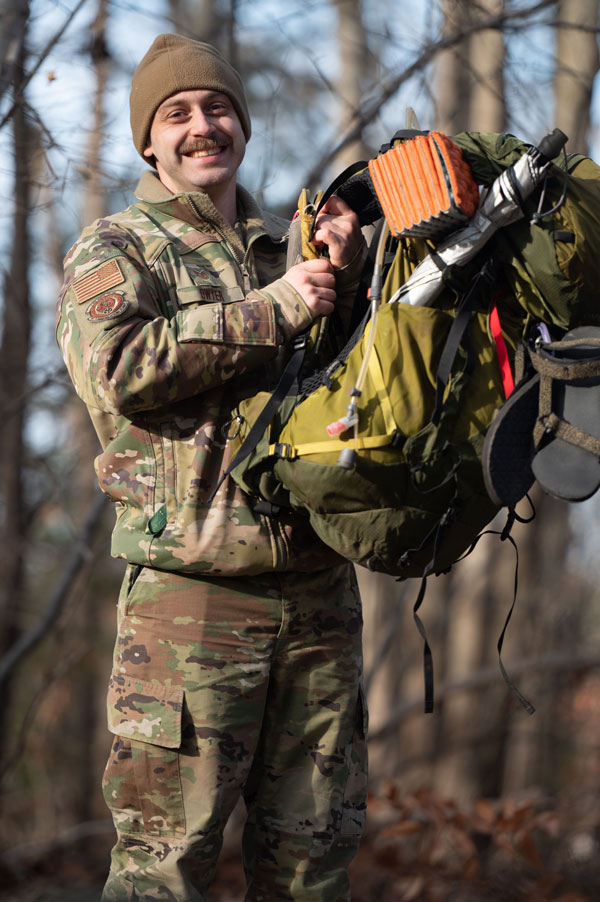
Pease Air National Guard Base, New Hampshire. (January 2, 2024): Some folks see the impossible and say, “no way”. Others see a daunting obstacle and ask, “why not”? Technical Sergeant Alan Dwyer, an operations network administrator with the 157th Communications Squadron, is just such a person. In this photo by Technical Sergeant Victoria Nelson, Dwyer poses proudly in his hiking gear after conquering the Appalachian Trail, one of the world’s most challenging achievements.
Beginning in March 2023, Dwyer hiked through fourteen states hiking over 2,200 miles at elevations as high as 460,000 feet, a remarkable feat only a select few have accomplished. According to the Appalachian Trail Conservancy, 75% of people who attempt the trek do not complete it. This legendary trail, which begins at Springer Mountain, Georgia, and stretches along the east coast all the way to Katahdin, Maine, is the longest foot path in the world. The challenge is so popular that more than three million people traverse segments of the trail each year.
- Details
- Hits: 1390
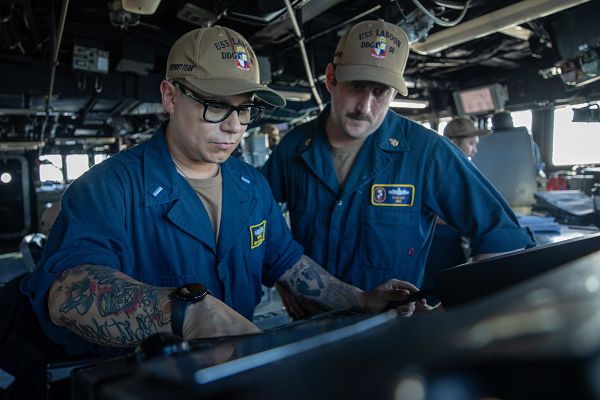
Bab Al-Mandeb Strait. (January 6, 2024): Iranian-backed Houthi rebels continue to fire missiles and drones at commercial shipping transiting the Red Sea and the USS Laboon, an Arleigh Burke-class guided-missile destroyer, has responded. In this photo by MC3 Alice Husted, Lieutenant Junior Grade Ronnie Brooks, left, and Chief Quartermaster Kyle Lux monitor navigation as their ship transits the Bab Al-Mandeb Strait, a waterway vital to the world economy.
The US military reports the USS Laboon shot down four drones launched from Houthi-controlled areas of Yemen in the southern Red Sea on Saturday and the warship also answered distress calls from two commercial vessels.
Responding to these brazen attacks, the U.S. has launched Operation Prosperity Guardian, a multinational task force assembled to confront threats in the Red Sea and Gulf of Aden. More than twenty countries have agreed to participate to ensure free navigation for all countries through this economically vital trading route.
Since the beginning of Operation Prosperity Guarding, roughly 1,500 commercial vessels have sailed through the Red Sea safely. The alternative is to divert shipping around the African Cape of Good Hope, a journey that adds ten days or more to delivery times globally. These delays have the potential to severely damage the world economic order.
- Details
- Hits: 1130

Arlington National Cemetery, Virginia. (December 29, 2023): It is America’s sacred promise to every servicemember, you will not be left behind. In this photo by Elizabeth Fraser, Soldiers assigned to the 3rd U.S. Infantry Regiment, known as “The Old Guard,” and the U.S. Army Band, “Pershing’s Own," conduct full military honors Army Corporal Gordon D. McCarthy, an Army Soldier killed during the Korean War. His niece, Marilyn Stanton, received the U.S. flag from the honor guard along with the thanks of a grateful nation. The efforts to bring Corporal McCarthy home represent the determination of the United States to account for every servicemember killed or missing, no matter how long it takes.
McCarthy’s unit was attacked by enemy forces near the Chosin Reservoir, North Korea, in one of the bloodiest battles of the war. After the battle, McCarthy's remains were not recovered and he was reported missing in action. He remained officially missing until he was officially accounted for on February 13, 2023, 73 years after his death.
According to Arlington National Cemetery Historian Kevin M. Hymel, Corporal McCarthy lived a hard life before he fell in battle. His mother died soon after he was born and he was raised by his grandparents while his father worked. His father later died in a workplace accident when he was just fifteen.
After graduating high school, McCarthy joined the Army’s 7th Infantry Division’s Headquarters and Headquarters Company, 1st Battalion, 32nd Infantry and was deployed to Korea. At time of his death, McCarthy was participating in Task Force Faith, an ill-fated effort to rescue units about to be surrounded by Chinese forces.
- Details
- Hits: 1085
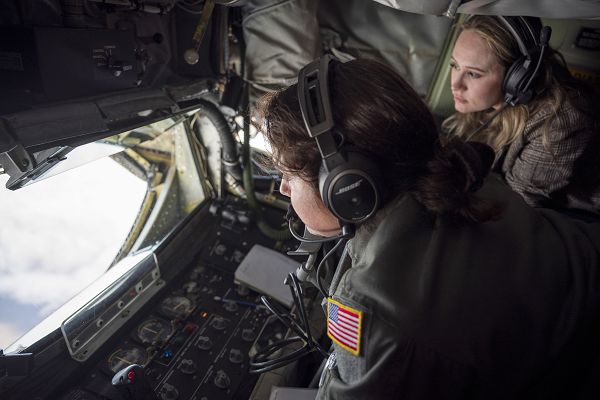
Fairchild Air Force Base, Washington. (December 29, 2023): In the above photo, Air Force Airman 1st Class Amanda Garcia, left, performs aerial refueling while a military spouse looks on. These spouse incentive flights are one of many efforts by the Air Force to strengthen military families. The Air Force recognizes the key role spouses play in the success of the mission and works hard to “keep it in the family” for its members.
America asks a lot of its 710,000 military families.
According to a recent DOD survey, 74% of active-duty spouses have experienced their spouses being deployed for longer than 30 days. These constant relocations and long deployments are the reason military families have the highest divorce rate of any career field, according to U.S. Census Bureau. Military spouses are also far less likely to participate in the labor market than the general working age population, 57 percent compared to 76 percent, according to a survey by the U.S. Chamber of Commerce. Military spouses suffer three times the national unemployment rate even though most (89 percent) have at least some college and 15 percent have advanced degrees.
- Details
- Hits: 1200
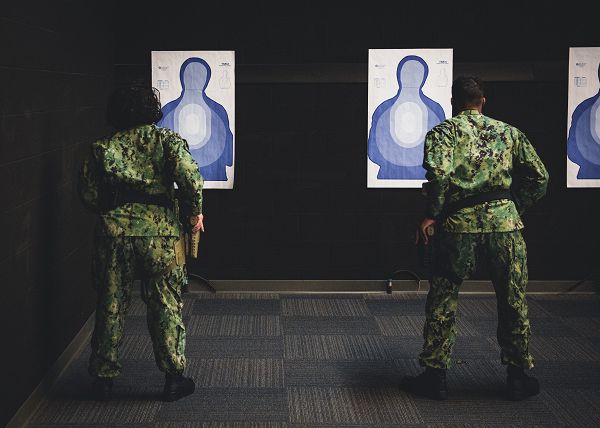
Great Lakes, Illinois. (December 31, 2023): In this photo by MC2 Stuart Posada, Navy recruits practice handling and firing procedures during weapons familiarization training at the USS Missouri Small Arms Marksmanship Trainer at Recruit Training Command (RTC). The RTC is the Navy’s only “boot camp” that trains more than 40,000 recruits a year to defend America at sea.
What is Basic like for America’s Sailors?
It begins with “Sailorization,” the process a recruit goes through to adjust to the war-fighting culture of the Navy. Enlistees are taught self-discipline and to live by the core values of honor, courage, and commitment to America’s defense.
The first week involves in-processing including physical and psychological assessments of a recruit’s fitness to serve. The real training begins in weeks two and three, which are considered the most difficult for most trainees as they adjust to Navy life.
Weeks four through six are the “hands on” portion of recruit training that includes the essentials of knot tying and line handling, firefighting, firearms training, and first aid. Week seven is an extensive evaluation of a recruit’s academic and physical skills. The final week is called “Battle Stations” where Sailors demonstrate their knowledge and skills as they would aboard ship.
- Details
- Hits: 1226
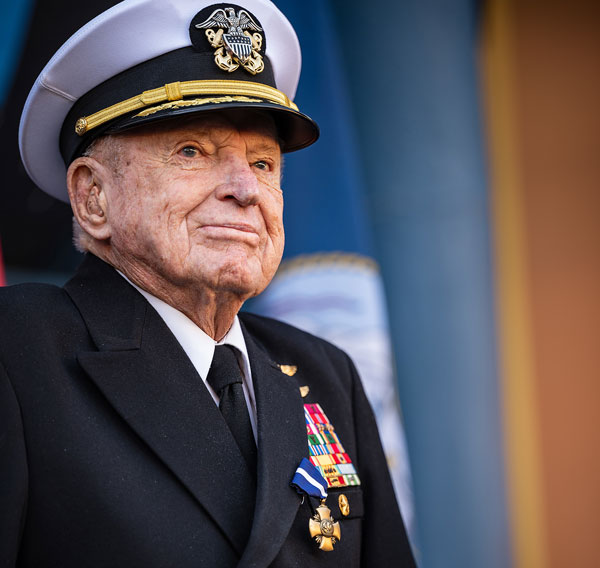
San Diego, California. (January 1, 2024): The greatest fighter ace in American history kept his exploits a secret from everyone… for 50 years. Retired Captain E. Royce Williams (above) was awarded the Navy Cross this week for his actions as a fighter jock during the Korean War. His solo dogfight with seven Soviet MiG-15s has been called "one of the greatest feats in aviation history" by military experts. Unfortunately for Captain Williams, he would not be able to tell his story for decades for national security reasons.
It was November 18, 1952, when the National Security Agency, using a variety of eavesdropping technologies, listened in on Soviet Navy communications and learned they were sending fighters south to observe the American aircraft carrier USS Oriskany which was operating in the Sea of Japan. Captain Williams and his comrades were dispatched to intercept the MiGs but, to keep the Soviet Union from learning how good their covert listening systems were, the NSA demanded they erase all traces of the resulting dogfight.
US Intelligence reports believed the MiGs were seeking revenge after Williams and other American aircraft had conducted an attack in northeastern North Korea near the Soviet border, early that morning.
Once airborne, two of the four U.S. planes developed mechanical issues that forced them to return to the carrier leaving Williams and his wingman, Dave Rowlands, to defend the carrier against the incoming MiGs.
After a MiG fired on Williams, the longest solo aerial dogfight in history was underway. When his wingman’s guns jammed, Williams found himself alone surrounded by seven enemy fighters. In the thirty plus minute battle that ensued, Williams shot down four of the MiGs while another crashed on its way back to its base in Vladivostok, Russia.
Williams’ plane was so severely damaged in the encounter that it could only pitch up and down and had to perform a high-speed landing to prevent stalling. Repair crews reported his plane was peppered with 263 holes.


